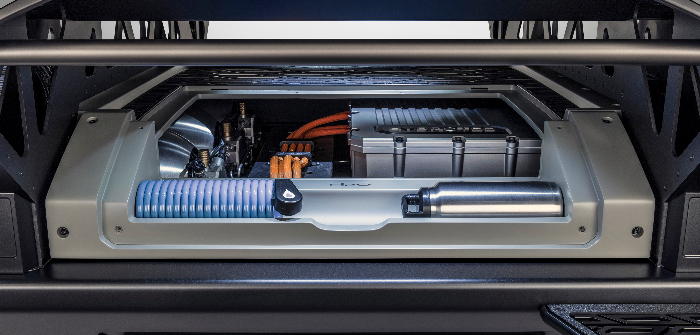General Motors (GM) is to unveil its first flexible fuel cell electric platform featuring autonomous capabilities. The Silent Utility Rover Universal Superstructure (SURUS) has been designed for commercial use – however, the project could be adapted for military use, and will debut at the Association of the US Army (AUSA) autumn meeting.
Fitted with the company’s newest Hydrotec fuel cell system, autonomous capability, and truck chassis components, the platform is claimed to deliver high-performance, zero-emissions propulsion. While delivering an impressive 645km of range, thanks to two advanced electric drive units, four-wheel steering, and a lithium-ion battery system.
Additionally, GM claims Hydrotec offers high wheel torque, extended operating range, and reduced odor, acoustic and thermal signatures.
As GM continues to work toward a zero-emissions future, the SURUS platform offers a solution which can scale to larger vehicles and operate over long distances. This means the project can deliver highly mobile autonomous capability, and agility in predictable terrain.
“SURUS redefines fuel cell electric technology for both highway and off-road environments,” said Charlie Freese, executive director of GM Global Fuel Cell Business. “General Motors is committed to bringing new high-performance, zero-emission systems to solve complex challenges for a variety of customers.”
Meanwhile GM has acquired lidar technology developer Strobe. As part of the deal, Strobe’s engineering team will work closely with GM’s cruise automation experts to define and develop next-generation solutions for self-driving vehicles.
“Strobe’s lidar technology will significantly improve the cost and capabilities of our vehicles so that we can more quickly accomplish our mission to deploy driverless vehicles at scale,” said Kyle Vogt, founder and CEO, Cruise Automation.
“The successful deployment of self-driving vehicles will be highly dependent on the availability of lidar sensors,” added Julie Schoenfeld, founder and CEO, Strobe.
“Strobe’s deep engineering talent and technology backed by numerous patents will play a significant role in helping GM and Cruise bring these vehicles to market sooner than many think.”
October 11, 2017


